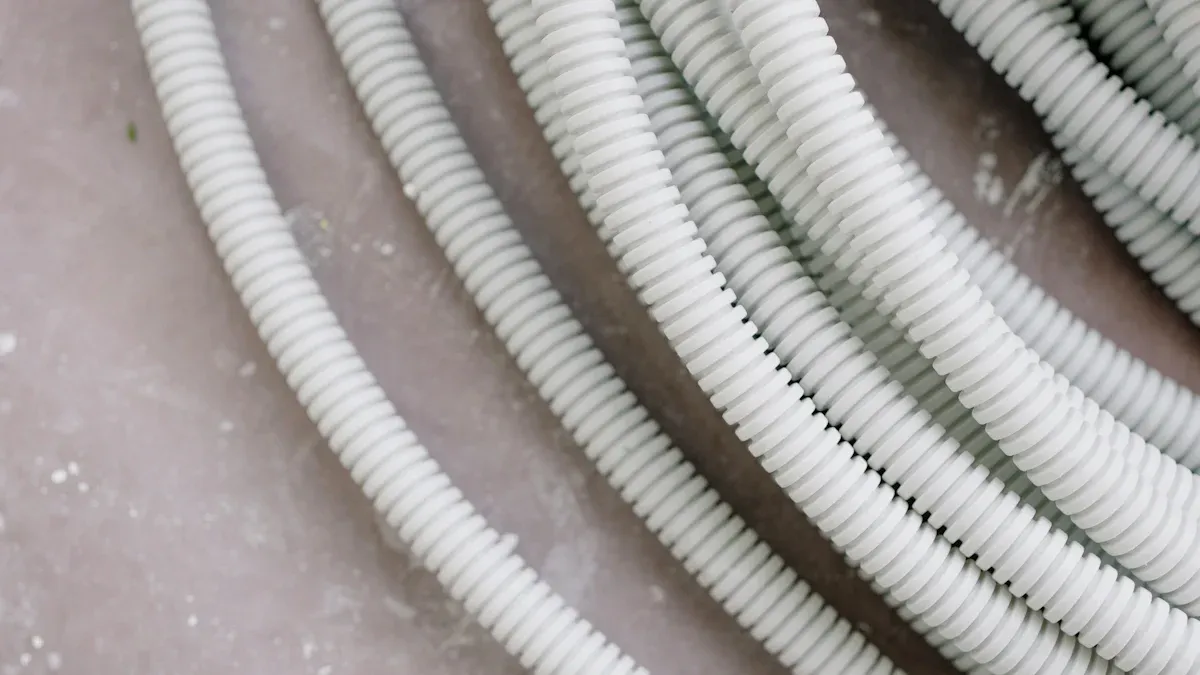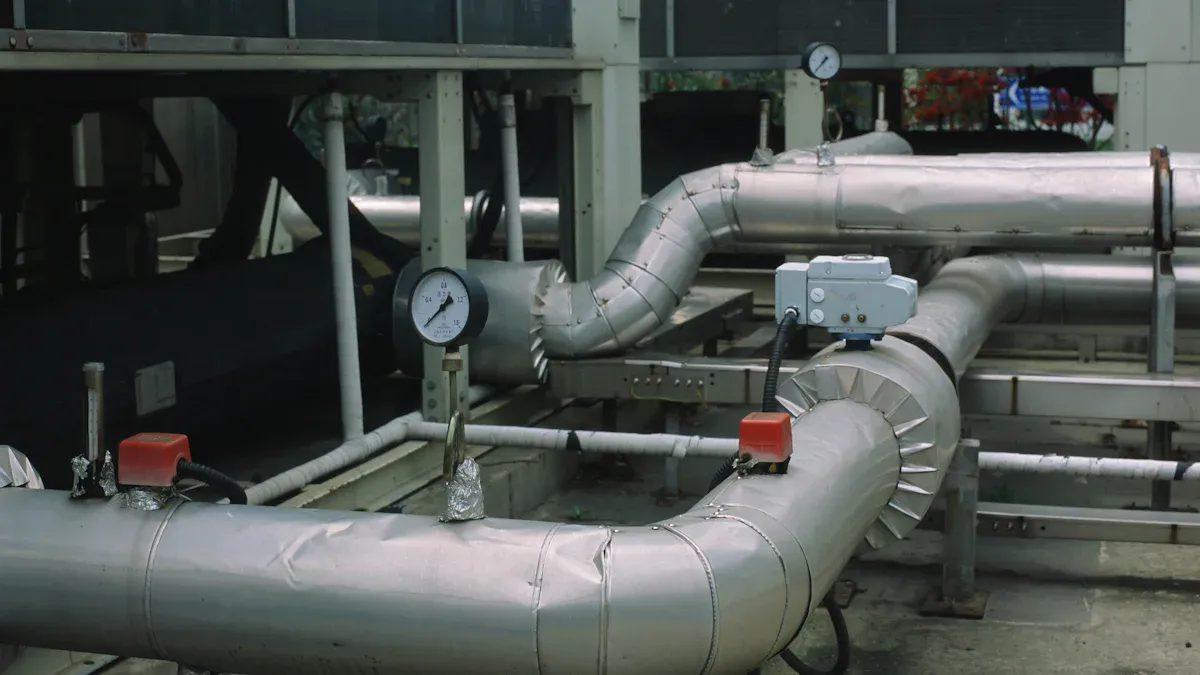What is 70% Shrinkage PET Heat Shrink Tubing and Where is it Used

You can use 70% shrinkage pet heat shrink tubing for strong, thin protection. It works well for wires or other parts. This tubing is made from pet, which is a tough plastic. It shrinks tightly around things when you add heat. Pet stays clear and does not get cloudy. It also resists chemicals and gives a tight seal. You see pet heat shrink tubing where you need strength and flexibility. The 70% shrinkage pet heat shrink tubing shrinks much more than normal tubing. Many people use pet heat shrink tubing for electronics and batteries. It is also used for medical devices. When you use pet heat shrink tubing, it looks neat and covers well. The pet material keeps the tubing light but strong. You will find 70% shrinkage pet heat shrink tubing useful in many places. It is great when you need tight and safe coverage.
Key Takeaways
70% shrinkage PET heat shrink tubing gets much smaller when heated. It shrinks down to 30% of its first size. This makes it fit wires and parts very tightly and safely.
The tubing is made from strong PET plastic. It does not let water, chemicals, or heat get through. It also stands up to pressure. This makes it great for electronics, cars, and medical tools.
The tubing is thin but still very strong. It protects well without making things heavy or big.
PET heat shrink tubing follows strict safety rules. It is safe for medical tools. It can handle different ways to get cleaned and sterilized.
It is easy to use: measure and cut the tubing. Slide it over the part. Heat it with a heat gun. This gives a neat and tough cover.
70% Shrinkage PET Heat Shrink Tubing

PET Material
PET heat shrink tubing is made from polyethylene terephthalate, or PET. This plastic is strong and tough. PET does not let water in, so it keeps wires safe from water. It also blocks chemicals and oils. This makes PET heat shrink tubing good for hard jobs. PET keeps its shape when heated. It does not melt or fall apart easily. You can use PET heat shrink tubing where it gets hot or there is a lot of pressure.
Tip: PET heat shrink tubing follows strict safety rules. It passes ISO 10993 and USP Class VI tests. This means you can use it for medical tools and electronics.
Here is a table that lists some key facts about PET heat shrink tubing:
Property | Value/Description |
|---|---|
Dielectric Strength | Greater than 4,000 V/mil |
Dielectric Constant | 3.3 |
Dissipation Factor | 0.0025 |
Volume Resistivity | 10^18 Ohm-cm |
Surface Resistivity | 10^14 Ohm/square |
Temperature Range | Long-term: -196°C to 135°C; Short-term: up to 200°C; Melting point: 235°C |
Mechanical Strength | High tensile strength, resists stress without deforming |
Chemical Resistance | Unaffected by common sterilizing agents |
Biocompatibility | Meets ISO 10993 standards |
Shrinkage Behavior | Tight fit with recovery >20% due to orientation and draw-down during heating |
PET heat shrink tubing gives strong protection, even in hard places.
Shrinkage Ratio
PET heat shrink tubing has a high shrink ratio. This means it can get much smaller when heated. The 70% shrinkage PET heat shrink tubing can shrink its width by up to 70%. This lets you cover many shapes and sizes. You always get a tight fit.
The product guide says this tubing can get 70% thinner. This shows how well it shrinks. You can use it on wires, connectors, or odd shapes. The tubing wraps close and leaves no open spots. This keeps out dust, water, and chemicals.
Note: A high shrink ratio means you only need one size for many uses. You do not have to buy lots of different sizes.
How It Works
PET heat shrink tubing is made in a special way. First, factories melt PET pellets and make them into tubing. They stretch the tubing and cool it fast. This keeps the tubing wide.
Next, the tubing is cross-linked. This uses radiation, like electron beams or UV light. Cross-linking helps the tubing remember its small size.
When you heat the tubing with a heat gun, the PET gets soft. The tubing remembers its small shape and shrinks tight around what it covers. The high shrink ratio lets the tubing shrink a lot for a snug fit.
Here is a table that explains the steps:
Aspect | Description |
|---|---|
Cross-linking Method | Radiation (electron beam, UV, etc.) gives the tubing its memory |
Polymer Processing Steps | Melt PET pellets → Shape into tubing → Stretch and cool → Cross-link |
Expansion Ratio | Tubing can expand to twice its original diameter |
Thermal Behavior During Use | Heating melts crystals, tubing shrinks back to original size |
Additional Treatments | Some tubing has adhesive linings or colorants |
Application Method | Use a heat gun to shrink tubing; avoid overheating |
You can use PET heat shrink tubing for many things. It works for electrical insulation and medical device safety. The high shrink ratio and strong PET material give safe, lasting coverage.
Features & Benefits
High Strength & Thin Wall
PET heat shrink tubing is strong and has a thin wall. The PET material makes it work well for many jobs. It has high tensile strength, so it keeps wires safe. The tubing is light but still very strong. You get good protection without making things heavy.
Here is a table that shows how PET heat shrink tubing is different from other materials:
Property | PET Heat Shrink Tubing | Comparison Material(s) |
|---|---|---|
Tensile Strength | Exceeds 107 N/m² (ASTM D2671) | Lower in elastomer and polyolefin tubing |
Shrink Ratio | 2:1 (thin wall, tight fit) | Lower or not specified |
Mechanical Strength | High | Moderate to low |
Weight Efficiency | High strength-to-weight ratio | Lower due to thicker walls |
You can use PET heat shrink tubing when you need something strong and light. The thin wall saves space and keeps things lighter. This is important for medical and electronics work.
Protective Barrier
PET heat shrink tubing protects wires and other parts. It acts like a shield against damage, chemicals, and water. The tubing can shrink up to 70%, so it fits many shapes and sizes.
PET heat shrink tubing gives a strong shield for hard materials.
It helps protect electrical parts from electricity.
The tubing starts shrinking at a low heat, so it is easy to use.
Thin walls and a straight seam make sizing fast.
You can use this tubing for medical, car, and electronics safety.
PET heat shrink tubing keeps out dust, water, and chemicals. It works well in tough places. The tubing also insulates and protects sensitive parts.
Tip: PET heat shrink tubing is great when you need both protection and chemical resistance.
Biocompatibility
PET heat shrink tubing is safe for medical use. It meets strict biocompatibility rules. The tubing passes ISO 10993 tests, so it is safe for the body. It also has USP Class VI certification, which means it is safe for medical tools.
Here is a table with facts about biocompatibility and safety:
Property/Metric | Details/Values |
|---|---|
Biocompatibility | Compliant with ISO 10993 standards |
Safety Certification | USP Class VI certification |
Sterilization Resistance | Withstands autoclaving, gamma radiation, and ethylene oxide |
Quality Assurance | ISO 13485 certification and batch testing |
PET heat shrink tubing can handle many ways to sterilize it. You can use it in hospitals and labs. Its biocompatibility makes it safe for medical devices like neurostimulator leads. You get safety, protection, and good performance in one product.
Applications

Electrical & Electronics
PET heat shrink tubing is used a lot in electronics. It protects wires, cables, and circuit boards from harm. You can use it for wire harnesses, battery packs, and motors. It also works for transformers and capacitors. The tubing covers connections and blocks dust and water. It keeps out chemicals too. It helps keep cables neat and safe.
Electronics companies like ultra-thin PET heat shrink tubing. It gives good electrical insulation and resists chemicals. The tubing is strong and fits tightly. This keeps devices safe. The market for PET heat shrink tubing is growing quickly. Here are some facts:
Statistic / Insight | Details |
|---|---|
Market Size (2023) | About $1.4 billion |
Market Forecast (2032) | About $2.3 billion |
CAGR | 5.6% |
Key End-User Segment | Electronics (insulation, cable management, protection) |
Ultra-thin PET Tubing Usage in Electronics | About 150 million units each year |
Material Advantages | Great insulation, chemical resistance, strong |
Regional Markets | North America, Europe, Asia-Pacific (fastest growth) |
Leading Companies | TE Connectivity, 3M, HellermannTyton, Molex |
PET heat shrink tubing is a top pick for insulation and safety. It resists heat and chemicals, so it works well in electronics.
Automotive & EV
PET heat shrink tubing is used in cars and electric vehicles. It gives light but strong protection for wires and batteries. In electric vehicles, you need good insulation and flame resistance. PET heat shrink tubing does both.
PET layflat tubing is used for battery insulation in electric cars.
It has high dielectric strength for safe insulation.
The thin wall keeps cars light and efficient.
The tubing shrinks tightly to fit many shapes.
You can shrink the tubing fast at low heat.
PET heat shrink tubing keeps battery packs clean and safe. It stops debris from getting in. You can use it for battery protection outside the cell. This is important for safety. Some products, like Electrolock’s 740 HS and 800 FRC, shrink in about 10 seconds at 100°C. This gives quick, even protection for all shapes.
The market for PET heat shrink tubing in cars is growing. In 2024, it was worth $1.27 billion. Experts think it will reach $1.86 billion by 2033. It is used most for car wiring and battery insulation. You can trust PET heat shrink tubing to protect your vehicle parts.
Medical Devices
PET heat shrink tubing is used in many medical devices. It is strong, clear, and safe for the body. You can use it for making catheters and covering wires in medical tools. It is also used for neurostimulator leads and other device parts.
PET heat shrink tubing gives a thin, tough cover for medical devices. It resists chemicals and can be sterilized many ways. You can use it in hospitals and labs where safety is important.
Medical device makers use PET heat shrink tubing for:
Making catheters with a smooth, strong cover.
Insulating wires in medical devices like neurostimulator leads.
Bundling and protecting wires in surgical tools.
Covering sensors and connectors in test equipment.
PET heat shrink tubing stands up to chemicals and sterilization. It keeps devices clean and safe. Medical device makers trust it for its high quality and safety. You get a tight fit, clear look, and strong protection.
Note: PET heat shrink tubing meets ISO 10993 and USP Class VI rules. You can use it for patient contact and important medical jobs.
Other Uses
PET heat shrink tubing is used in many other ways. It works for protecting cables in machines and heating elements. It is also used in aerospace parts. You can use it to bundle cables or cover sensors. It protects small parts from dust and water.
Some common uses are:
Protecting cables and hoses.
Covering heating elements in appliances.
Insulating capacitors and small motors.
Giving a clear, tough cover for delicate parts.
PET heat shrink tubing is flexible and strong. It resists chemicals, heat, and wear. Many industries use it because it is easy to install and works well.
Choosing & Using PET Heat Shrink Tubing
Selection Tips
When you pick PET heat shrink tubing, you should think about a few things. First, check the size of your wires or parts. Measure how wide they are. Pick tubing with a shrink ratio that fits well. This helps the tubing fit tight and not leave gaps. It also stops the tubing from being too tight. A good fit helps your device work better and last longer.
Think about where your device will be used. PET tubing works in hot, cold, or chemical places. It can handle temperatures from -55℃ to 135℃. It shrinks when heated between 60℃ and 125℃. If your device is outside in rain, snow, or sunlight, PET tubing protects it well. You should also think about things like rubbing, bending, or sparks. If fire is a worry, pick tubing that does not burn easily.
If you make medical devices, check for safety and quality rules. PET tubing meets ISO 10993 and USP Class VI rules. This means it is safe to touch the body. It also passes tests for steam and radiation sterilization. Your device can be cleaned with high heat and still work well.
Tip: Ask experts before you buy. They can help you choose the right tubing and avoid mistakes with size or cleaning.
Installation
It is easy to put on PET heat shrink tubing if you follow some steps. First, cut the tubing to the right length. Slide it over the part you want to cover. Use a heat gun to warm the tubing. Move the heat gun slowly and evenly. The tubing will shrink and fit tightly around your part. This gives a smooth and strong cover.
Always test the tubing on a sample before making many devices. This helps you see if it fits and works well. PET tubing stays strong and flexible after many cleanings. It works well for medical devices because it keeps its quality after steam, radiation, or hydrogen peroxide cleaning. You can trust PET tubing to keep your device safe for people.
Here is a table to help you remember the steps:
Step | What to Do |
|---|---|
Measure | Check device diameter and tubing size |
Cut | Trim tubing to fit your device |
Slide | Place tubing over the device part |
Heat | Use a heat gun to shrink tubing evenly |
Test | Check fit and quality after shrinking |
PET heat shrink tubing is a good way to protect your device. You get a strong, clear, and safe cover every time.
Now you know that 70% shrinkage PET heat shrink tubing is strong and thin. You can use it for many things. It works for electrical, car, and medical jobs. This tubing is special because it is safe for the body. It is used in medical devices a lot. The tubing fits tightly and looks clear. It is also easy to put on. If you need safe and strong covers for medical tools, this tubing is a good choice. Pick it for your next medical project.
FAQ
What does "70% shrinkage" mean for PET heat shrink tubing?
"70% shrinkage" means the tubing can shrink to 30% of its original width when you apply heat. This gives you a tight, secure fit over many shapes and sizes.
Can you use PET heat shrink tubing outdoors?
Yes, you can use PET heat shrink tubing outdoors. It resists water, sunlight, and chemicals. This makes it a good choice for outdoor wires and cables.
How do you shrink PET heat shrink tubing safely?
You should use a heat gun. Move the heat evenly over the tubing. Do not overheat it. The tubing will shrink and fit tightly. Always test on a sample first.
Is PET heat shrink tubing safe for medical devices?
Yes, PET heat shrink tubing is safe for medical devices. It meets ISO 10993 and USP Class VI standards. You can use it for tools that touch the body.

